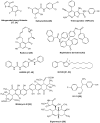Progress Overview of Bacterial Two-Component Regulatory Systems as Potential Targets for Antimicrobial Chemotherapy
- PMID: 32977461
- PMCID: PMC7598275
- DOI: 10.3390/antibiotics9100635
Progress Overview of Bacterial Two-Component Regulatory Systems as Potential Targets for Antimicrobial Chemotherapy
Abstract
Bacteria adapt to changes in their environment using a mechanism known as the two-component regulatory system (TCS) (also called "two-component signal transduction system" or "two-component system"). It comprises a pair of at least two proteins, namely the sensor kinase and the response regulator. The former senses external stimuli while the latter alters the expression profile of bacterial genes for survival and adaptation. Although the first TCS was discovered and characterized in a non-pathogenic laboratory strain of Escherichia coli, it has been recognized that all bacteria, including pathogens, use this mechanism. Some TCSs are essential for cell growth and fitness, while others are associated with the induction of virulence and drug resistance/tolerance. Therefore, the TCS is proposed as a potential target for antimicrobial chemotherapy. This concept is based on the inhibition of bacterial growth with the substances acting like conventional antibiotics in some cases. Alternatively, TCS targeting may reduce the burden of bacterial virulence and drug resistance/tolerance, without causing cell death. Therefore, this approach may aid in the development of antimicrobial therapeutic strategies for refractory infections caused by multi-drug resistant (MDR) pathogens. Herein, we review the progress of TCS inhibitors based on natural and synthetic compounds.
Keywords: drug resistance; environmental response and adaptation; histidine kinase; infection control; response regulator; two-component regulatory system; virulence.
Conflict of interest statement
The authors declare no conflict of interest.
Figures



References
-
- O’Neill J. Antimicrobial Resistance: Tackling a Crisis for the Health and Wealth of Nations. [(accessed on 20 December 2014)];2014 The Review on Antimicrobial Resistance. Available online: https://amr-review.org/sites/default/files/160525_Final%20paper_with%20c....
Publication types
Grants and funding
LinkOut - more resources
Full Text Sources

